Starbat's Togruta Cosplay Headpiece Tutorial
Making A Togruta Headpiece: 14 Easy-ish Steps
As it so happens, Togruta are some of my favorite aliens in the universe. They're colorful, they're badass hunters, and they've got a very distinctive silhouette. Plus, with the popularity of Ahsoka Tano (much deserved, she is super f**king awesome), there's been an amazing boom in cosplay of this delightful species.
However, most of the cosplay I've seen centers around Ahsoka Tano and her relatively small montrals (the horn-like projections on top of a Togruta head) and lekku (the three "head-tails" that hang down from the montrals).
 |
| Ahsoka is not impressed |
And while this is wonderful, I've always been in love with Shaak Ti's much larger montrals and lekku.
 |
| Shaak Ti is also unimpressed |
And because I have no sense of reasonable project ambitions, I wanted to make for myself a Togruta headpiece of such majestic Shaak Ti proportions. So here's the story.
Materials
Montrals
- 1 Cheap Bike Helmet. The cheaper the better, I got mine at 5 Below.
- 1 Sheet of Foam Board. You can get this at most big box stores or craft stores, it's dirt cheap
- 2-3 Cans of Expanding Insulation Foam. You can find these at any decent size hardware store, they generally run about $5-8 each. Again, you don't need anything fancy here, the cheaper the better.
- 3-5 Sheets Tissue Paper
- 1 Bottle White Glue (such as Elmer's)
Lekku
- ~2 yrds Basic Knit Material
- 1 Large Bag Craft Stuffing Material. I think I used some Poly-Fil I had lying around
- 1 Bag Foam Microbeads to fill in the gaps left by the fiber fill. (To be clear, I am talking about small styrofoam beads like those used in bean bags and slime, not the weighted plastic pellets used in things like Beanie Babies
- Note: both the Poly-Fil and the microbeads were used to create a soft, mobile lekku, which worked great until they were covered with Plasti Dip and stiffened up. If you want to cut costs, go ahead and use just the Poly-Fil or carve the lekku out of a foam block like those used for cushions
- 1 Foam Cushion Blank. Get something pretty thick, this will be used to create wedges to transition from the montrals to the lekku, and to create the paddle-shaped end of the rear lekku
Etc.
- ~15 Small Wood Screws
- 1 yd of 1-2 inch Wide Elastic Banding (or something similar, this doesn't have to be exact)
- 2-3 Cans of Plasti Dip (I'm sure you can use a dupe as well). This is going to be your base color unless you want to paint the whole thing over, so choose wisely. I went with the traditional white base common to Togruta.
- 1 Can Colored Spray Paint. This will be the color for your markings, so pick your favorite. Classic Togruta colors are teal, navy, etc, but they are shown in the Clone Wars with a wide variety of colors, so go nuts. For the paint itself I used a Colorshot Outdoor Upholstery Spray because I thought it might be more durable. It...might have worked? I've had some paint wear, but not a lot, so draw your own conclusions.
- 1 Marker. Preferably a fine line in your marking color. This will be used purely to draw your markings on before painting them
Tools
- Box Knife. Either a couple cheap ones of something with spare blades, because they are going to dull pretty quickly
- Scissors
- Basic Sewing Materials (needle and thread. You can use a sewing machine but it's not necessary)
Okey dokey, welcome to hell. This is definitely my biggest project to date, and it was a journey, a quest, and a goddamn voyage of self discovery. I'm not saying it's the best Togruta headpiece out there, but I think it's pretty damn cool if you don't want to buy one or figure out latex casting. Major props to the Fretful Ferret, I based my build off of her Ahsoka Tano headpiece tutorial and I would highly recommend it to others (https://fretful-ferret.tumblr.com/post/165768299446/how-the-heck-did-i-make-that-ahsoka-tano).
The Montrals!
Step 1: Creating a Base
As I mentioned in the material list, this step is easy. I bought the cheapest bicycle helmet I could find (courtesy of 5 Below) and ripped the hard plastic coating off the top (this was...almost too easy. I don't know that I would trust this helmet to save my head).
 |
| Like really, there were about 3 dots of glue holding the plastic onto this |
Then I marked out the areas of the helmet I wanted to pare down so that it would fade better into my skull. Focus on cutting off the brim of the helmet.
 |
| This is my best unimpressed face |
And cut away using a box cutter or other carving device until you have a shape you like.
Step 2: Create a Skeleton for the Montrals
Technically I guess you don't need to do this, but I found it very helpful to first make a 3-D layout of what the montral would look like, and then create a guide when carving the insulation foam into the final shape.
For this step, I first drew and cut the basic shape of the montral out of foam board.
Then I cut out a series of discs in descending sizes to approximate the diameter of each montral along its length. To fit them together, I simply cut a small slit in each disc, and slits in the montral shape where each disc would sit, and slid the discs onto the montral.
Step 3: Join the Montral Skeleton to the Base
This is easy. Go ahead and figure out where you want the montral to sit and mark it on the helmet. Use the box cutter to carve out a narrow channel so that the montral skeleton can sit in it. Add glue (I use E600 or something similar) until it's reasonably stable.
 |
| *Confused Viking noises* |
 |
| Or is it more Loki vibes? |
Step 4: Add Insulation Foam
Fun time. Take a can of insulation foam and spray is all over the montral skeletons and the top of the helmet. Remember you're not trying to add much bulk to the front or back of the helmet, but don't worry too much about overflow. It does expand, and it is going to look nuts. Plus, you're going to carve everything away anyway. For me, this step only took one, maybe two cans of foam, and it will depend on how much structure you've created with your skeleton.
After you've made this monstrosity, remember to take a few pictures so that A) you always remember how stupid it looked because it's funny as hell, and B) so that you can show people some serious Princess-Diaries-style before and after photos. You've got time, because this amount of insulation foam will probably take a few days to fully set (at least it does in hot, humid Florida).
Step 5: Carve the Montrals
This isn't exactly easy (depending on how good you are with a box cutter. I'm not great), but it's not really that hard either. Even though what you start with looks like an unmanageable fungal mass, the skeleton you cleverly made makes it surprisingly easy to get everything back to the shape you wanted. Just carve until you find that skeleton, and then follow it along. I used purely carving at this point, rather than sanding the horns, but you certainly can sand the foam down as well.
 | ||
| Behold the Eye |
 |
| It kind of looks like a sheep that's gone way too long without a shearing |
And before you know it, you've got a pretty decent set of horns.
NOTE THE SECOND: At this point, I went on to make and attach the lekku. When I did attach the lekku, I found that I didn't really like how artificial and obvious the attachment points looked.
 |
| Ooh, two eyes this time |
At that point I decided to add more foam around the attachment points. Theoretically you could skip that point and try to create a more robust helmet now, but I think the way that I did is actually better. Carved like this, attaching the lekku is easy. Plus, adding more foam after protects and hides the established attachments. More on this process will be discussed later.
The Lekku!
Step 6: Creating a Bad Sock
So, after a lot of wishy-washy confusion, I decided that the best way to make lekku would be to make three triangles of fabric, sew them into tubes, and stuff them. It worked pretty well, all things considered. As such, your first order of duty is to decide how long you want your lekku to be. I went with Shaak Ti's prequel style length, which is about, uh, groin length (I'm so sorry, I'm not sure how else to measure that), with a slightly longer rear lekku (uhhh, butt-covering length? Sorry again).
 | |||
| Judgmental Shaak is back |
 |
| Ah yes, show me that sexy back |
Additionally, you have to decide how thick you want your lekku (damn it, now everything sounds dirty to me). As far as I'm concerned, the world is your oyster. Shaak Ti's original costume (seen above) had kind of thin, snake-y lekku, but some of her animated appearances and action figures show a somewhat thicker lek.
Anyway, make your own decision. I would start with the side lekku rather than the rear lek, as that one is a slightly different style. Go ahead and cut out a tapering triangle shape from your knit material.
 |
| Fabric flat |
 |
| Fabric folded in half in half (for a better approximation of what the finished lek will look like) |
Once you've got your triangle, fold it in half and sew it shut to make an open-ended tube. Once you turn that inside out so that the seam is on the inside, you've got yourself a bad sock.
Step 7: Stuffing the Bad Sock
What it says on the tin, kids. I ended up making this part way more complicated than it needed to be. I found it difficult to get a smooth filling with the Poly-Fil alone (it always looked lumpy). I know there's probably better ways to fix that problem, but I decided to do so by gradually adding in foam microbeads to fill out the gaps in the lekku stuffing.
 |
| Two of the horsemen of the apocalypse, I swear to God |
This worked great, but was largely negated when I covered the lekku in a crap-load of Plasti Dip, which created a thick shell around the lekku. If you're going to use the Plasti Dip coating like I did, you don't need the foam microbeads (they're not cheap).
Whatever you're stuffing with, make sure to leave the last 10 or so inches un-stuffed.
Step 8: Create the Rear Lek
So the rear lek is a little different from the side lekku on a traditional Togruta. Photos were a little difficult to find when I was planning this project, so bear with me. In general, the rear lek is a little flatter and broader than the side lekku.
 |
| Butt, butt, butt butt, butt butt |
Now, this looked difficult (plus, as I said, getting a good picture of a Togruta rear was a little difficult and, uh, NSFW once upon a time), so I did something a little different. Rather than make the whole lek flat and shaped, I decided to make a spade-shaped end to the rear lek. To this end, I made a leaf-shaped end to the sock, plus I made the rear lek a little longer and a little wider than the side lekku.
 |
| Shown here folded in half |
Then I cut a rounded spade shape out of the foam cushion blank.
This was inserted into the sock end, and a leaf shape from the knit material was sewn in to form a foot on the inside of lek.
From here, the stuffing process remained the same as for the side lekku. Remember to leave some room at the end.
Step 9: Creating an Attachment Point
Here comes the more difficult part. What you're left with after stuffing is a straight tube. What will happen if you tie off the tube here is that you get a tapered attachment end.
What you want is more of a cone with a thick base. More than that, what you really want is a cone that attaches perpendicular to the side of your helmet/face, right over the ear (or at the base of your skull in the case of the rear lek).
How I decided to achieve this involved taking the rest of the foam cushion blank and cutting disc-shaped wedges out of the foam (I don't seem to have a picture of these anywhere, so use your imagination).
 |
| It's all wedges |
Then I shoved about three of these into the top of each side lek, short sides together and long sides together to create an arc. Then I gathered the loose end of the fabric together to create a knot, and glued/sewed it shut.
Attachments and Coverings!
Step 10: Attach the Lekku
This is pretty simple. Get out your wood screws (I just grabbed a few from my dad's collection of bullshit).
From there I chose 4-5 screws for each lek. For each I worked them through the edge of the top of the lek, piercing both the fabric and the foam wedge inside.
 |
| Yup, we're looking at this again |
Then I coated each of the screws' exposed threads in an all-purpose glue (again, I mostly used an E-6000/Shoe Glue product) and screwed them directly into the bike helmet. Let them set overnight at least to ensure a strong bond.
Step 11: Finalize Your Shape
As discussed above, this was the point at which I decided to go back and add some more insulation foam around the edges of the lekku. To protect the lekku (I wasn't sure I wanted to spray insulation foam directly onto the fabric) I glued a little skirt of wax paper over the top of the lekku and just cut away any spare visible paper after carving everything back into shape. Otherwise this is just like the original montral covering, except that I was kind of winging it (don't judge, damn it).
Put it on, carve it back, rinse and repeat until you're satisfied with the result.
Optional Step 11.2
In the Shaak Ti promotional pictures, it looks like there are some ridges along the top edges of the lekku.
To create this look, I chose to add strips of elastic banding. This is easy. Cut a couple strips of elastic banding (2-3 for each lek), and sew/glue them into place around the base of each lek. This creates the ridged effect, and also confuses the join between lek and montral.
 |
| I have done so many terrible things to Fred the Head |
Step 12: Papier Mache the Montrals
Don't flee, this is way easier than the French makes it sound. Basically, you want to create a bunch of strips of tissue paper (about 1 inch wide. It's better to tear them than to cut them, the ragged edges will blend together). Then you make a glue/water mix in about a 1:1 ratio. Apply the glue and wind the strips around the montrals in overlapping strands. Because the tissue paper is so fine, I found it easier to paint some glue directly onto the montrals, add a strip of paper, and then paint more glue on top of the strip. Get everything nice and soaked through and mush everything around a little bit to get it as flat and as bonded as possible
Step 13: Coat the Montrals and Lekku in Plasti Dip
This is a simple step, but it took me f**king ages. I don't know if anyone else has this problem, but I used spray cans of Plasti Dip, and it always seems to create a beaded texture on my surface rather than a flat texture. This meant that I had to go over each layer with my fingers and smooth things out. Plus, I found that it took a LOT of Plasti Dip to cover the natural texture of the knit and the papier mache. If you do it this way, just know that I feel your pain, and that the end result is awesome, I swear.
Step 14: Make the Markings
This was really the fun part for me. First of all, I made a bunch of drawings laying out what I wanted the lekku and montrals to look like. Traditionally, Togruta have some variety of striped markings, but it's a wide variety, so have fun. I chose mostly chevrons and some Pacific Northwest Indigenous-inspired markings. In addition, you have to decide how clean you want your markings. I went with the sharper edges of the animated Star Wars series, as opposed to the blurrier live action markings.
First I drew out the markings with a fine point Sharpie in my marking color (teal in my case). I found this the best method because A) it actually transfers well onto the Plasti Dip (unlike a pencil lead), and B) it's easy to erase with a little alcohol wipe or nail polish remover if you mess it up. Afterwards I painted over it with the marking paint (spraying didn't work for me, so I ended up spraying it onto a paper plate and painting it on with a brush like a maniac). The beautiful thing here is that you're replicating an organic pattern, which means that you're entitled to some uneven-ness and wiggling. It doesn't matter as long as it mostly matches.
It took me a couple layers of paint to achieve an opaque marking, but it was well worth it. After that, all you need to do is decorate your headpiece. However, that is going to be another post because this one is entirely too long as it is.
So at this point, just sit back and appreciate your work.
And get ready to do some more work.
Pros and Cons
Alright, this was quite a process. I worked, I failed, I got pissed and left it in a corner, I worked, I broke my arm (unrelated, I swear), and finally: TA-DA!
So, with that in mind, it didn't quite come out the way I had planned. Don't get me wrong, I love my headpiece, but there are definitely changes I would make should I (yeah, I probably will) make another one. But it's still awesome, so I figured I would lay out the good and bad traits for you as it stands.
The Good:
- It's lightweight. Foam and stuffing, that's all it is. Most of the weight comes from the Plasti Dip, honestly.
- It's durable and waterproof. I've worn this to two conventions and a few photoshoots. Now that's not much, but I've also left it in a car for days in the summer Florida heat, I've sweat (heavily) in it, shoved it in corner, stored it laying down, standing up, crammed into chairs. Nothing fazes it. I've had a little paint from the markings wear off over time (on the inside where it rubs against me and my clothes), but that's an easy fix.
- All the materials are relatively cheap and easy to find. I'm avoiding working with latex because I'm afraid of it, but no one needs to be afraid of this build. No special techniques, just a little painting, a little carving, not much else.
The Bad:
- The lekku are stiff. Like, they're still mobile enough for walking around a convention and some posing, but they don't move very organically. They were actually perfect before painting, but the sheer amount of Plasti Dip has created a shell around them. For V.2 I'm thinking of using the same stuffed sock approach, but maybe covering them in a layer of dance tights to give them a more mobile, skin-like texture rather than using Plasti Dip.
- The rear lekku sticks out like a dinosaur tail unless you stand very straight. I like where it's positioned on the head, so I just deal with it. Again, this is also a symptom of my lekku-too-stiff syndrome (whoops, that sounded dirtier out loud than it did in my head).
- It can get a bit uncomfortable. It's not heavy, but all the weight is centered on the top of the head. After wearing it all day, I generally end up with a bit of a headache and some neck pain, so plan ahead and pack some ibuprofen.
- Mobility is lower. I can turn my head a bit, but looking up or down is difficult, and both peripheral vision and hearing are limited. But that's likely going to be the case in any version of a Togruta headdress this large.
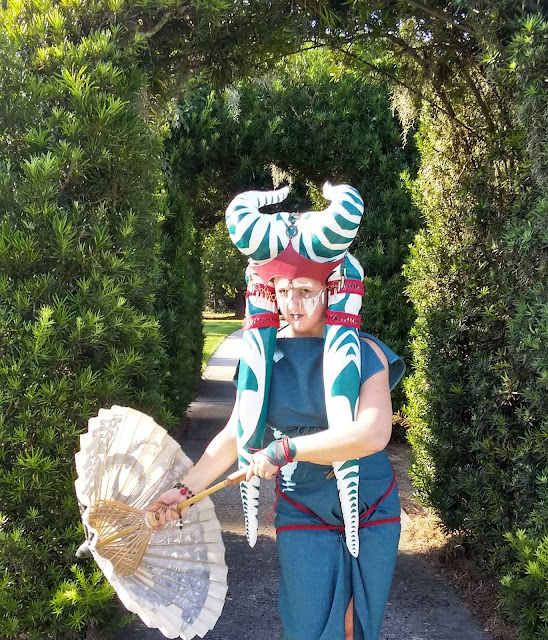
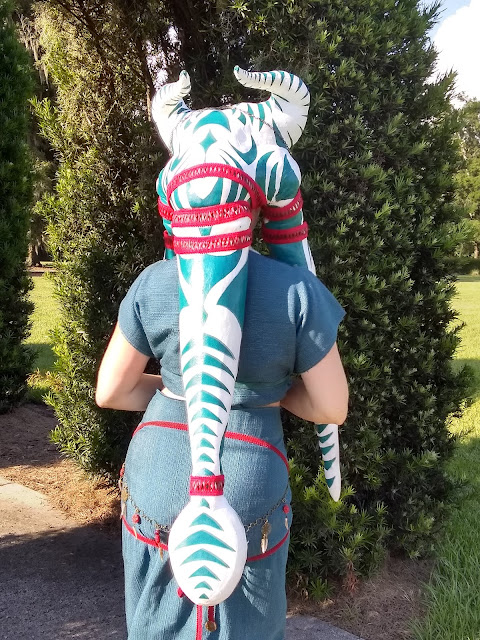























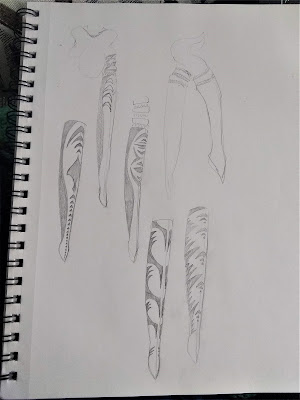




.jpg)
.jpg)
.jpg)

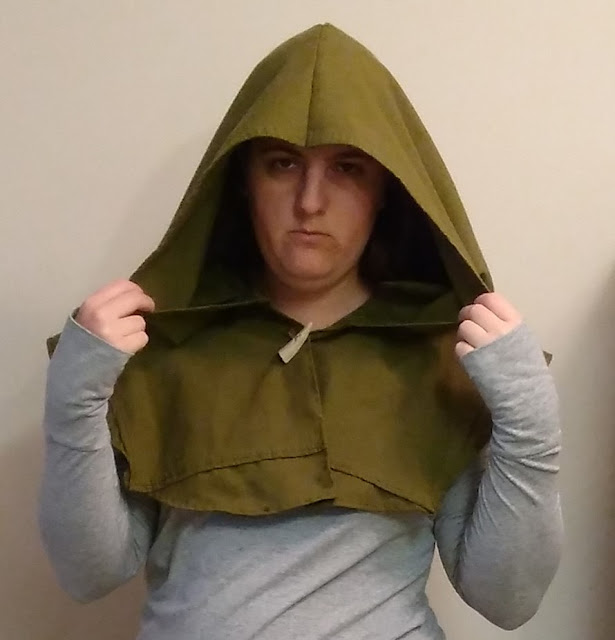
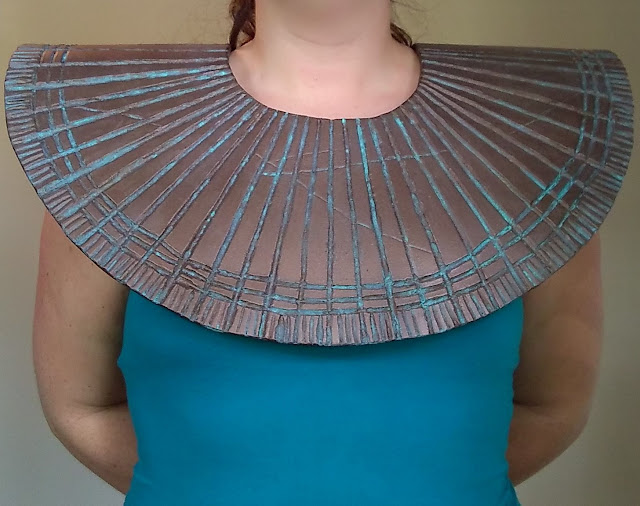

Comments
Post a Comment